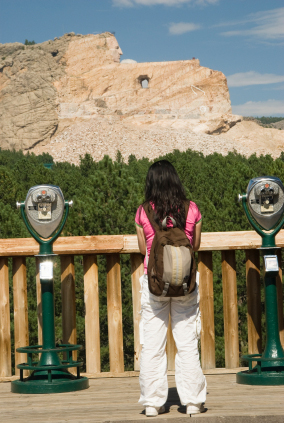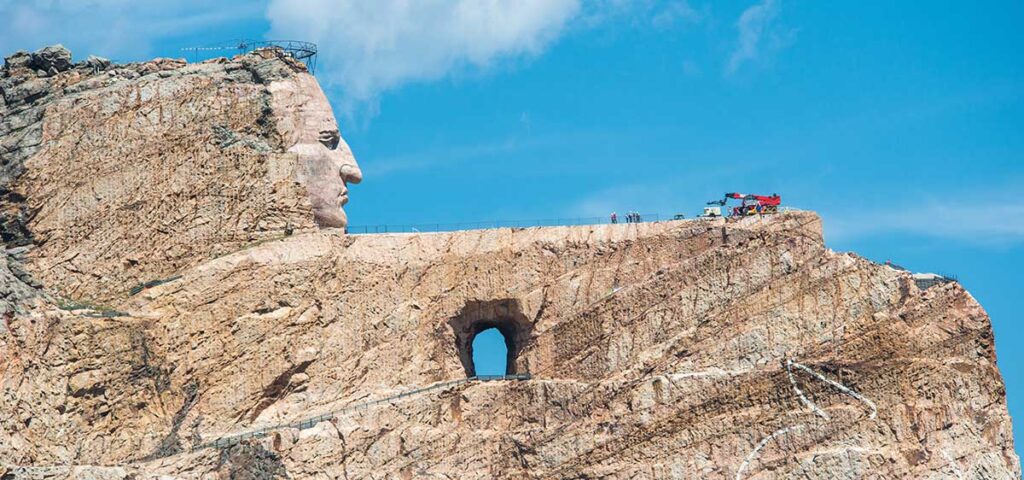Quick Facts: Crazy Horse Monument
- Location: Black Hills. In Custer County, SD.
- Artist: Korczak Ziolkowski
- Year Started: 1948. Project is still ongoing.
- Size: 564′ long X 563′ tall. Crazy Horse Memorial is the world’s largest Mountain Carving in progress
- How Is It Financed: Crazy Horse is financed by admissions and contributions and does not accept federal or state funding.
- Visitors: Over 1 million visitors each year.
The world’s largest mountain sculpture, Crazy Horse Memorial, is located in the Black Hills of South Dakota near the town of Custer. The magnitude of this memorial rivals the significant accomplishments of Crazy Horse, a legendary Native American leader.
 In 1939, Chief Standing Bear wrote a letter to Horczac Ziolkowski, an assistant sculptor working on the carving of Mount Rushmore, asking him to visit the Black Hills and carve a mountain memorial honoring Native Americans. Chief Standing Bear’s letter to Ziolkowski stated, “My fellow chiefs and I would like the white man to know that the red man has great heroes, too.” The carving of the Crazy Horse Memorial officially began on June 3, 1948.
In 1939, Chief Standing Bear wrote a letter to Horczac Ziolkowski, an assistant sculptor working on the carving of Mount Rushmore, asking him to visit the Black Hills and carve a mountain memorial honoring Native Americans. Chief Standing Bear’s letter to Ziolkowski stated, “My fellow chiefs and I would like the white man to know that the red man has great heroes, too.” The carving of the Crazy Horse Memorial officially began on June 3, 1948.
In 1949, Ziolkowski decided to devote the rest of his life to forging the Crazy Horse Memorial. From 1949 until his death in 1982, Ziolkowski drilled, bulldozed, and dynamited nearly 7.4 million tons of rock from the site.
The legacy of Crazy Horse Memorial did not end with the death of Ziolkowski. Today, seven of Ziolkowski’s children and his widow Ruth continue with Horczac’s dream of completing the memorial. When finished, the memorial will be 641 feet widenearly the length of two football fieldsand 563 feet high. By comparison, the entire carving of Mount Rushmore could fit in the area of Crazy Horse’s face and flowing hair.
The Heart of the Memorial: Crazy Horse’s Legacy
The Inspiration Behind the Monument
The Crazy Horse Memorial, a colossal tribute to the Native American warrior Crazy Horse, finds its roots deeply embedded in the rich history of the Black Hills. Nestled in the rugged terrain of Thunderhead Mountain, the monument’s inception was as much a response to the nearby Mount Rushmore as it was a celebration of Native American culture. The idea was born from a desire to honor the heritage and values of the indigenous people, particularly the Lakota tribe, to whom Crazy Horse belonged.
The vision for the memorial was first conceived by Chief Henry Standing Bear, who sought to create a symbol of Native American heroism and resilience. He reached out to sculptor Korczak Ziolkowski in 1939, extending an invitation to carve a mountain as a testament to the spirit of Crazy Horse and the Native American people. This invitation set in motion a project of unprecedented scale, one that would demand decades of dedication and become a pilgrimage site for those looking to immerse themselves in the history and majesty of the American West.
While the Crazy Horse Memorial is a singular attraction, it’s part of a larger tapestry of historical and natural wonders in South Dakota. Visitors often Explore South Dakota’s National Parks, including the iconic Mount Rushmore and the dramatic landscapes of the Badlands. For those seeking adventure, the Lewis and Clark Trail and the Missouri River offer a plethora of water activities.
Crazy Horse: The Warrior and the Legend
Crazy Horse, the Lakota leader, stands as a towering figure in the history of the American West. His legacy as a warrior and a defender of his people’s way of life resonates through the ages, inspiring the monumental Crazy Horse Memorial in South Dakota. This colossal sculpture is more than just a tribute; it’s a testament to the indomitable spirit of the Native American resistance against encroachment on their lands and culture.
Crazy Horse’s tactical prowess and leadership were evident in several key battles against the United States Army. Perhaps most famously, he played a pivotal role in the Battle of the Little Bighorn, where his forces, alongside those of Chief Sitting Bull, secured a significant victory. His commitment to his people’s sovereignty made him a symbol of Native American pride and resistance.
The story of Crazy Horse is interwoven with the rich tapestry of Lakota culture and the broader narrative of the American frontier. His life and legend continue to captivate and educate those who visit the memorial and the surrounding South Dakota attractions, which include museums and parks across regions like Western, Central, and Eastern. These institutions showcase the state’s history and heritage, offering a deeper understanding of the figures that shaped it.
The Ongoing Journey of Carving History

The Crazy Horse Memorial stands as a testament to the enduring spirit of the Native American people and the legacy of the warrior it commemorates. This monumental project, located in South Dakota, is not only a tribute but also a masterclass in persistence and dedication. Financed primarily through visitor fees and private donations, the Memorial’s journey is a story of unwavering commitment.
The carving process itself is a marvel of modern engineering and artistry. Unlike other historical monuments, there is no government funding; every chisel mark and dynamite blast is backed by the support of those who believe in the vision. Here’s a glimpse into the progress made over the years:
- 1948: The project begins with Korczak Ziolkowski at the helm.
- 1982: Korczak passes away, but his family continues the work.
- 1998: Crazy Horse’s face is completed and dedicated.
- Present: Work continues on the outstretched hand and horse’s head.
As the world’s largest mountain carving in progress, the Memorial faces unique challenges. Weather, scale, and the sheer complexity of the design all play a role in the timeline of completion. Yet, the project moves forward, with each year bringing it closer to realization. The Crazy Horse Memorial, once complete, will stand as a symbol of cultural pride and historical recognition for generations to come.
Artistry Meets Ambition: Sculpting a Colossus
The Artistic Vision of Korczak Ziolkowski
The Crazy Horse Memorial, a testament to the enduring spirit of the Native American people and their heroes, owes its inception to the artistic vision of Polish American sculptor Korczak Ziolkowski. This monumental sculpture, set in the Black Hills of South Dakota, was envisioned as a response to the nearby Mount Rushmore, a creation of Gutzon Borglum which was completed in 1941 and features the faces of four U.S. presidents. The initiative for Mount Rushmore, led by Duane Robinson to boost tourism, inadvertently set the stage for the creation of the Crazy Horse Memorial.
Sculptor Korczak Ziolkowski began the colossal task in 1948, with a clear goal to honor the heritage and culture of Native Americans through the figure of Crazy Horse, who represents the courage and freedom of indigenous people. Unlike Mount Rushmore, which visitors enjoy for its ranger-guided tours and patriotic events, the Crazy Horse Memorial is not just a sculpture but a sanctuary for the preservation of Native American culture.
Here are some key aspects of Ziolkowski’s vision:
- A dedication to historical accuracy and cultural sensitivity.
- The integration of the natural landscape with the sculpture.
- A focus on education and cultural enrichment through the associated Indian Museum of North America and the Native American Educational & Cultural Center.
Ziolkowski’s commitment to the project was unwavering, and his legacy continues through the ongoing work of his family, ensuring that the story of Crazy Horse is told for generations to come.
Challenges in the Making: Weather, Scale, and Politics
The Crazy Horse Memorial, a testament to the resilience and determination of those who have worked on it, has faced formidable challenges since its inception. Weather has been a relentless adversary, with South Dakota’s extreme conditions ranging from blistering summers to frigid winters, each bringing its own set of complications to the carving process. The sheer scale of the monument, intended to be the world’s largest mountain carving, presents another layer of complexity. The vastness of the project demands not only time and patience but also a significant amount of precision to ensure that every detail of Crazy Horse’s figure is accurately represented.
Political hurdles have also played a role in the memorial’s journey. Navigating the intricacies of funding, land rights, and the sensitivities surrounding the depiction of a Native American hero have required careful diplomacy and unwavering commitment. Despite these obstacles, the project continues, driven by a vision that transcends the stone from which it is carved.
To appreciate the magnitude of these challenges, consider the following aspects:
- Weather Impact: Seasonal weather patterns significantly affect work schedules and the preservation of the monument.
- Engineering Feats: Innovative techniques are employed to manage the scale of the project, including controlled explosions and precise drilling.
- Political Landscape: The memorial’s progress is influenced by ongoing discussions with local governments, Native American communities, and private entities.
As visitors explore South Dakota’s diverse natural and historical sites, they are often awestruck by the Crazy Horse Memorial, which stands as a beacon of cultural significance amidst attractions like Good Earth State Park, Custer State Park, and Mount Rushmore National Memorial.
The Ziolkowski Family: Generations of Dedication
The Crazy Horse Memorial is not just a testament to the legacy of the Native American warrior it depicts, but also to the enduring commitment of the Ziolkowski family. Korczak Ziolkowski began the colossal task in 1948, and since his passing, his family has taken up the mantle, ensuring that his artistic vision continues to progress. The project has become a multi-generational endeavor, with each new generation of Ziolkowskis inheriting not just the responsibility of sculpting the mountain, but also the passion for the cause it represents.
The family’s dedication is evident in the way they have managed to keep the project privately funded, relying on visitor fees and donations rather than government grants. This approach has allowed them to maintain creative control and stay true to Korczak’s original vision. Here’s a glimpse into the family’s involvement over the years:
- Korczak Ziolkowski: Founder and original sculptor
- Ruth Ziolkowski: Took leadership after Korczak’s death
- Ziolkowski children: Many have roles in the ongoing work and management
- Grandchildren and beyond: Continuing the legacy into the future
The Crazy Horse Memorial stands as a symbol of perseverance, much like the spirit of Crazy Horse himself. As visitors explore nearby attractions like the Big Pig Dig at Badlands National Park or the Ben Reifel Visitor Center, they are reminded of the dedication that the Ziolkowski family has poured into this monumental piece of art, nestled in South Dakota’s unique landscape.
Beyond the Stone: The Cultural Impact
A Symbol of Native American Pride
The Crazy Horse Memorial, nestled in the Black Hills of South Dakota, stands as a towering tribute to the Native American warrior and serves as a profound symbol of Native American pride. This colossal sculpture is more than just a tourist attraction; it’s a bold statement of identity and resilience in the face of centuries of adversity.
The memorial’s significance extends beyond its impressive physical presence. It’s a place where the past and present converge, offering a space for reflection and education about the rich history of the United States’ indigenous peoples. Visitors from all walks of life come to witness the grandeur of the monument and leave with a deeper understanding of the Native American culture and the values it embodies.
Here’s a glimpse into the impact of the Crazy Horse Memorial:
- A testament to Native American heritage
- A source of inspiration for indigenous peoples
- An educational hub for those seeking to learn more about Native American history
- A reminder of the importance of preserving cultural legacies
As one of South Dakota’s popular state parks, the area surrounding the memorial also plays a crucial role in promoting Native American pride. Parks like Custer State Park not only offer natural beauty but also serve as sites where cultural significance is both celebrated and respected.
Educational Outreach and the Crazy Horse Dream
The Crazy Horse Memorial extends beyond a mere monument; it embodies a hub for cultural exchange and education. The Crazy Horse Memorial Foundation emphasizes educational outreach, aiming to foster a deeper understanding of Native American cultures and histories. This initiative is a testament to the Crazy Horse dream of preserving and celebrating the rich heritage of Indigenous peoples.
Key educational programs include:
- The Indian University of North America, a summer program for college students.
- The Indian Museum of North America, which houses an extensive collection of Native American artifacts.
- The Native American Educational and Cultural Center, offering workshops and lectures.
These programs not only educate but also inspire visitors and students alike, creating a lasting impact on the community and beyond. The foundation’s efforts ensure that the story of Crazy Horse and the Native American experience resonates with future generations, fulfilling a vision that is as educational as it is monumental.
Controversies and Criticisms: Balancing Perspectives
The Crazy Horse Memorial, while a symbol of Native American heritage, has not been without its share of controversies. Critics argue that the monument does not accurately represent Native American perspectives, with some tribal members expressing that they were not consulted about the project. The debate extends to the environmental impact of the carving and whether it aligns with the spiritual beliefs of the indigenous peoples regarding the sanctity of the land.
Despite these criticisms, supporters of the memorial emphasize its role in education and cultural preservation. They point to the positive attention it brings to Native American history and the opportunities it creates for dialogue and understanding. The memorial’s impact on the local economy is also significant, as South Dakota offers diverse attractions, including the memorial itself, which draws visitors from around the world.
To better understand the multifaceted views, here’s a breakdown of the key points:
- Representation: Concerns over the depiction of Crazy Horse and the involvement of Native Americans in the project.
- Environmental Impact: The alteration of the natural landscape and its implications.
- Cultural Sensitivity: The balance between honoring a legacy and respecting sacred traditions.
- Economic Benefits: The boost to tourism and local businesses due to the memorial’s presence.
Unseen Struggles: Stories from the Shadows
The Workers Behind the Scenes
The Crazy Horse Memorial, a colossal undertaking in South Dakota’s Black Hills, is not just a testament to the vision of its creators but also to the perseverance of the workers who toil behind the scenes. These unsung heroes are the backbone of the project, dedicating countless hours to the intricate process of sculpting and maintaining the monument. Their roles are diverse, ranging from skilled stone carvers to equipment operators, each playing a critical part in bringing the memorial to life.
The day-to-day reality for these workers involves a combination of technical expertise, physical labor, and a deep commitment to the cause. The challenges they face are not just physical; they must also navigate the complexities of a project that is as much about cultural significance as it is about artistic achievement. The following points highlight the multifaceted nature of their work:
- Mastery of stone-carving techniques and safety protocols
- Operation and maintenance of heavy machinery
- Adherence to artistic and cultural guidelines
- Collaboration with a team of diverse individuals
Despite the enormity of the task, the workers’ dedication remains unwavering. Their contributions are essential, yet often overlooked when the narrative of the memorial is told. It’s important to recognize that without their tireless efforts, the vision of the Crazy Horse Memorial would remain unfulfilled. As visitors marvel at the grandeur of the monument, it’s crucial to remember the hands that shaped it, the minds that planned each detail, and the spirits that continue to drive its progress.
Financial Hurdles and Fundraising Feats
The Crazy Horse Memorial, a testament to the resilience and determination of those who have worked on it, has faced its fair share of financial challenges. Funding the creation of such a monumental sculpture without government support has required innovative approaches to raising capital. The project has relied heavily on private donations, revenue from the visitor center, and the proceeds from the annual Volksmarch, a public walk that attracts thousands of participants.
To give an idea of the financial journey, here’s a snapshot of the fundraising efforts:
- Visitor Center Operations: A significant source of funding, the visitor center offers educational tours, gift shop sales, and special events.
- Private Donations: Contributions from individuals who believe in the vision of the memorial.
- Annual Volksmarch: This event alone has become a cultural phenomenon, drawing visitors and funds to the cause.
Despite the hurdles, the memorial has made impressive strides, with each dollar raised pushing the project closer to completion. The dedication of the team and the support of the community have been pivotal in overcoming these financial obstacles. As the memorial continues to grow, so does the need for sustained financial support, ensuring that the story of Crazy Horse is told for generations to come.
The Emotional Toll of a Lifelong Project
The creation of the Crazy Horse Memorial is not just a physical endeavor but also an emotional odyssey for those involved. The sheer scale and ambition of the project demand a lifetime of dedication, often passing from one generation to the next. The emotional investment is immense, with each setback and triumph resonating deeply with the creators and their families.
For the sculptors and workers, the memorial represents more than a job; it’s a calling that intertwines with their personal identities. The emotional toll includes moments of doubt, frustration, and fatigue, which are seldom seen by the public. Yet, the commitment persists, driven by a profound connection to the mission of honoring Native American heritage.
- The initial vision and passion that sparked the project’s inception.
- The personal sacrifices made by the Ziolkowski family and the extended team.
- The collective resilience in overcoming challenges and pushing the project forward.
- The pride and sense of accomplishment in each phase of progress.
In the shadows of the colossal sculpture, personal stories of perseverance and emotional labor unfold, often unnoticed. These narratives are as integral to the memorial as the stone from which it is carved. As visitors explore the diverse regions of South Dakota, engaging in activities like the Sturgis Motorcycle Rally or marveling at the natural beauty, the Crazy Horse Memorial stands as a testament to the unseen struggles that have shaped it.
Looking to the Future: What Lies Ahead
Completing the Vision: Timelines and Expectations
The Crazy Horse Memorial, a testament to the resilience and spirit of Native American culture, has been a work in progress since its inception in 1948. As we look towards the future, the completion of this colossal sculpture remains a topic of much anticipation and speculation. The timeline for the Memorial’s completion is not set in stone, with progress dependent on a variety of factors, including funding and the meticulous nature of the carving process.
While the full realization of Korczak Ziolkowski’s vision may still be years away, the current focus is on completing the outstretched arm of Crazy Horse and the horse’s head. These milestones are crucial in bringing the monument closer to its final form. The project operates without government funding, relying solely on private donations and the revenue generated from visitors who come to explore South Dakota’s natural wonders.
The expectations for the Memorial’s completion are intertwined with the desire to honor Crazy Horse’s legacy accurately and respectfully. It’s a balance of artistic integrity, cultural sensitivity, and the practicalities of executing a project of this magnitude. The journey to completion is as much a part of the story as the finished monument will be, symbolizing the ongoing commitment to preserving and celebrating Native American history.
Expanding the Visitor Experience
The Crazy Horse Memorial, already a beacon of cultural significance, is set to enhance its visitor experience further. The expansion plans include the development of new visitor centers that aim to enrich the educational journey of those who come to pay homage to this monumental tribute. These centers will serve as hubs for learning and engagement, offering a deeper dive into the history and significance of Crazy Horse and the Native American culture.
The proposed visitor centers will not only provide interactive exhibits but also house facilities for workshops, lectures, and cultural events. Here’s a glimpse of what visitors can expect:
- Interactive Exhibits: Engage with the story of Crazy Horse through state-of-the-art displays.
- Educational Programs: Participate in workshops and lectures that delve into the rich tapestry of Native American history.
- Cultural Celebrations: Experience the vibrancy of Native American culture with events and gatherings.
As the Memorial continues to evolve, these enhancements promise to create a more immersive and comprehensive experience for all who visit. The goal is to foster a greater understanding and appreciation of the legacy that Crazy Horse has left behind, ensuring that the narrative is not just seen, but truly felt.
Preserving the Legacy for Generations to Come
The Crazy Horse Memorial, a testament to the resilience and spirit of Native American culture, stands not just as a monument but as a beacon for future generations. Preserving the legacy of Crazy Horse and the values he stood for requires a multifaceted approach, ensuring that the story and significance of the memorial continue to inspire long into the future.
Key to this preservation is the integration of educational programs and cultural initiatives that engage the public and foster a deeper understanding of Native American history. These efforts are complemented by ongoing conservation measures to protect the integrity of the monument against natural and human-induced wear.
To encapsulate the commitment to longevity, consider the following strategic points:
- Continuous educational outreach to schools and communities
- Partnerships with Native American tribes to ensure cultural accuracy and respect
- Regular maintenance and conservation efforts to safeguard the monument
- Development of interactive exhibits and digital archives for global accessibility
As visitors from around the world Explore South Dakota’s campgrounds, bed & breakfasts, lodges & resorts, and vacation rentals, they not only witness the grandeur of the Crazy Horse Memorial but also partake in the region’s rich cultural tapestry. The memorial serves as a cornerstone for regional tourism, highlighting top attractions and events that celebrate the heritage it represents.
Visiting Today
More than 1.2 million people visit Crazy Horse Memorial each year. Many visitors make the pilgrimage annually to observe the progression of the carving. The face of Crazy Horse, measuring 87.5 feet high, was completed in 1998 and generated much enthusiasm among visitors.
The Crazy Horse Memorial project is funded entirely by visitor’s admission, private donations, and fundraising events. Each June, visitors to the site can participate in the Crazy Horse Volksmarch. The Volksmarch is an organized 6.2-mile wilderness hike through the surrounding areas of the site, with Crazy Horse’s outstretched arm as the turn-around point of the hike. Crazy Horse Volksmarch is the only time of the year when visitors are permitted to walk at the carving site. Crazy Horse Volksmarch draws approximately 15,000 participants each year, and is the most popular organized hike in the U.S.
In addition to the mountain sculpture, Crazy Horse Memorial also has a 40,000-square-foot welcome center with theatres, and is home to the Native American Educational and Cultural Center, and the Indian Museum of North America. While at the site, visitors may also enjoy viewing Ziolkowski’s log home studio and workshop, indoor and outdoor art galleries, and the museum gift shop.
While in the area, visitors are sure to enjoy Mount Rushmore, located just 17 miles northwest of Crazy Horse Memorial.
Great Faces. Great Places.
South Dakota is an incredibly unique state in that each region offers a completely different experience then the others. Check out each of the regions to see what each has to offer!

Western South Dakota
Featuring the Black Hills, Badlands, the Sturgis Rally. This region tends to be the most popular.

CENTRAL REGION
This region of South Dakota offers some of the best hunting and fishing in the entire central US.

Eastern Region
The eastern region is home to the largest city in the state and provides visitors with a true "prairie" experience.
